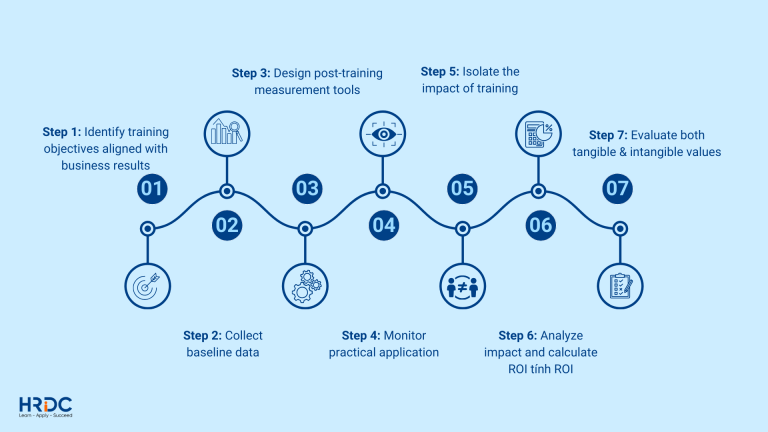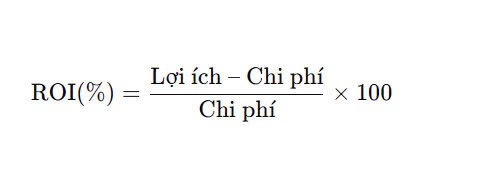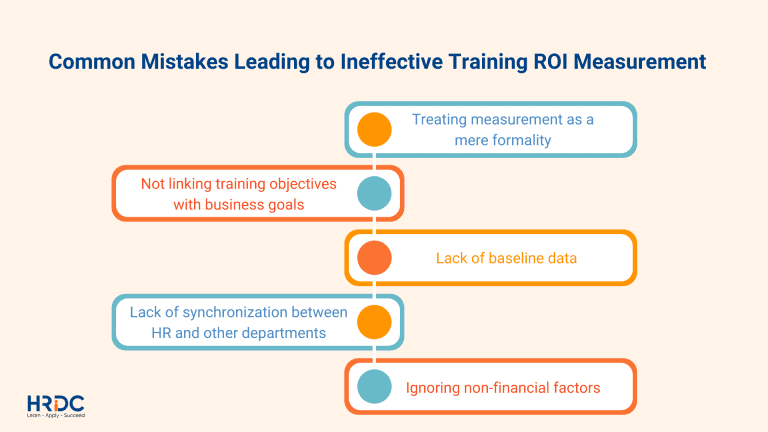According to Jack Phillips (2003), training should be viewed as a strategic investment rather than merely an operational expense. This implies that measuring the ROI of training not only helps safeguard the company's budget but also acts as a "shield" protecting the reputation of the L&D department within the organization. However, many L&D professionals still feel powerless when faced with the question: "How much revenue did a training course generate?"
1. Breaking Down Barriers to Measuring Training ROI
In an environment where businesses demand efficiency and transparency in investment, employee training is no longer simply a developmental activity. Now, every budget allocation needs to be justified by the specific value it delivers – and ROI (Return on Investment) is an increasingly expected metric in the L&D field.
However, reality reveals a significant gap between the desire to measure ROI and the actual ability of organizations to do so. Questions like, “How much sales did this course bring in?” or “What changes have occurred in employees after the training?” often leave training departments perplexed, even feeling helpless.
So, what are the reasons why businesses encounter difficulties when trying to measure ROI from training? How can L&D not only convince but also demonstrate the specific business value of each implemented program?
The answer begins with directly addressing the invisible yet prevalent barriers that are freezing measurement efforts within the organization.
2. Common Barriers Hindering Measurement
Most businesses, regardless of size, face challenges when attempting to evaluate the ROI of training.
Common barriers that make measurement difficult include:
- Training not aligned with specific business goals: Many programs are implemented based on intuition or general notions like “skill enhancement,” “inspiration,” or “internal training for fun,” lacking the crucial question: “What are we improving in business operations?”
- Lack of baseline data: Measurement is only meaningful when the “starting point” is known. The absence of baseline data means there are no benchmarks for comparison, making post-training evaluation subjective and less persuasive.
- Expectation of immediate results: The impact of training programs, especially soft skills or leadership development, is often indirect and requires significant time to manifest. Impatience and a lack of perseverance can lead to inaccurate assessments or premature conclusions about the program’s effectiveness.
- Difficulty in isolating the impact of training from other factors: An employee’s improved performance may not solely be due to the training course but could be influenced by external factors. Without appropriate analysis methods, it becomes challenging for L&D to prove what outcomes are a result of training versus external influences.
- Lack of tools and systems to support measurement: While models like Phillips and Kirkpatrick are widely used, many businesses still lack robust data collection tools. Without a data management system, any measurement efforts are ineffective and cannot be used for performance reporting.
- Lack of genuine leadership commitment to ROI measurement: When leaders are only concerned with “having training to meet quotas” without truly investing in defining objectives, standardizing evaluations, and allocating a measurement budget, all expectations for ROI remain theoretical.
3. The Phillips ROI Model – Standardizing How Businesses View Training Value
The Phillips ROI Model (developed by Jack Phillips based on the Kirkpatrick model) is a comprehensive tool that helps businesses evaluate training effectiveness from basic levels to specific financial outcomes.
Unlike the Kirkpatrick model, which includes only four levels and stops at Level 4 – Results, Phillips added Level 5 – Financial ROI. This model helps organizations measure the benefits derived from training compared to the costs incurred.
The 5-level structure of the Phillips ROI model:
4. The 7-Step Process for Measuring Training Effectiveness – Operationalizing the Phillips ROI Model
While the Phillips ROI model presents an ideal 5-level evaluation framework, to apply it practically, businesses can implement a logical 7-step measurement process that aligns with their current operational capabilities.
The 7-step process for measuring training effectiveness – Operationalizing the Phillips ROI Model:
-
Step 1: Identify training objectives aligned with business results
-
Training activities should begin with a “specific business problem” that needs to be solved. This helps align training with business goals, avoids deviation, and allows for measurable outcomes. This step forms the foundation for all subsequent measurement steps.
- Example: “Improve customer service skills to reduce complaints from 12% to below 5% within 3 months.”
-
-
Step 2: Collect baseline data
-
Before implementing the training program, gather relevant data related to the issues that need improvement. Examples include: Order closing rates, customer satisfaction levels, etc.
- Having a clear baseline makes post-training effectiveness measurement more objective and scientific, rather than relying on intuition.
-
-
Step 3: Design post-training measurement tools
-
Depending on the desired evaluation level according to the Phillips model, businesses should prepare appropriate tools.
Level Suitable Measurement Tools Level 1 – Reaction Post-course satisfaction surveys Level 2 – Learning Tests, case studies, mini-projects Level 3 – Behavior Manager feedback, 360-degree assessments Level 4 – Results Pre- and post-training KPI comparison - Example: After a sales closing skills training program, the sales team will take a post-course test, and their order closing rates will be monitored for the next 3 months.
-
-
Step 4: Monitor practical application
-
Learning only truly adds value when applied in real work scenarios. This “post-training” measurement step has the most significant impact. Monitoring methods include:
- Reports on practical application from trainees
- Feedback from direct managers
- Regular monthly/quarterly evaluations
- Example: After an internal conflict resolution training course, the frequency of arguments within the team decreased by 35% within 2 months.
-
-
Step 5: Isolate the impact of training
-
Not all improvements after training are solely attributable to the training course. Businesses need to differentiate to identify the pure impact of training. Common approaches include:
- Comparing a trained group with an untrained control group
- Controlling for external factors such as new policies, new tools, market changes, etc.
- Example: The trained group experienced a 12% increase in sales, while the untrained group only saw a 2% increase → the 10% difference can be attributed to the training effectiveness.
-
-
Step 6: Analyze impact and calculate ROI
- After collecting clear data, businesses need to convert it into specific financial values to calculate ROI.
Example: Cost of sales skills training for 50 people: 200 million VND. After training, sales increased by 1 billion VND in 3 months.
-
- ROI = [(1,000,000,000 – 200,000,000) / 200,000,000] × 100 = 400%
-
Step 7: Evaluate both tangible & intangible values
-
Not all benefits after training can be converted into monetary value. Training also brings many non-financial benefits such as: Employee satisfaction, reduced turnover rates, increased team cohesion, etc.
- Note: Businesses do not necessarily need to measure all 5 levels and 7 steps for every course. Be flexible in choosing the level appropriate for: Course objectives, investment scale, level of impact on business.
-
5. Common Mistakes Leading to Ineffective Training ROI Measurement
Despite the support of measurement tools and processes, many businesses still fall into the trap of “measuring without achieving meaningful results.” The reasons may stem from several common mistakes:
Common mistakes leading to ineffective training ROI measurement:
- Treating measurement as a mere formality: Many businesses only survey satisfaction levels and then assume a certain level of success. However, this level does not reflect the actual impact on work performance or business outcomes.
- Not linking training objectives with business goals: If training is not tied to specific KPIs, it becomes unclear what to measure, how to measure it, and what constitutes successful results.
- Lack of baseline data: Many programs are implemented without collecting prior data, leading to a lack of a basis for comparison and rendering post-training evaluation meaningless.
- Lack of synchronization between HR and other departments: Measuring ROI is not solely the responsibility of the training department. It requires coordination from middle management, the finance department, and cooperation from leadership levels. Without consensus, all measurement efforts easily become superficial.
- Ignoring non-financial factors: Some businesses overemphasize financial ROI and overlook soft values such as: Learning culture, proactivity, engagement levels, etc., leading to inaccurate conclusions about program effectiveness.
Conclusion: A New Mindset Towards Training and ROI Measurement
In the context of market volatility and increasing pressure to optimize costs, employee training is no longer a soft expense that can be easily cut. On the contrary, it is a strategic lever if businesses know how to invest and measure correctly.
A training program is only truly valuable when it contributes to solving a specific business problem. If this is not clearly defined from the outset, all measurement efforts become meaningless.
Instead of waiting until training ends to find ways to evaluate effectiveness, it is necessary to build a measurement mindset right from the program design phase, encompassing objectives, baseline data, evaluation tools, and mechanisms for monitoring practical application.
Technology is the foundation, but measuring ROI still requires a team that understands training objectives, knows how to coordinate across departments, and has the ability to turn data into action.
Not every program yields immediate results. Some impacts only appear after 3-6 months, or even a year. Measuring ROI is a continuous, systematic process that requires patience.
Related Articles:
- The Future of Work: What Does L&D Need to Prepare for Rapid Changes?
- L&D pro skills – HRDC
- 4 things you need to know about the R.O.I model in training effectiveness evaluation
- L&D Challenges in the Digital Era – 2025
_____
HRDC – Learn – Apply – Succeed
📌LTG: https://www.learntogrow.com.vn/nextgen-l_d
🌐Website: https://hrdc.com.vn
🚨Hotline: 0866 566 366 – 0585 27 28 29
📧Email: chamsockhachhang@hrdc.com.vn
🏬Address: Dolphin Plaza – 28 Tran Binh – My Dinh 2 Ward – Nam Tu Liem District – Hanoi







